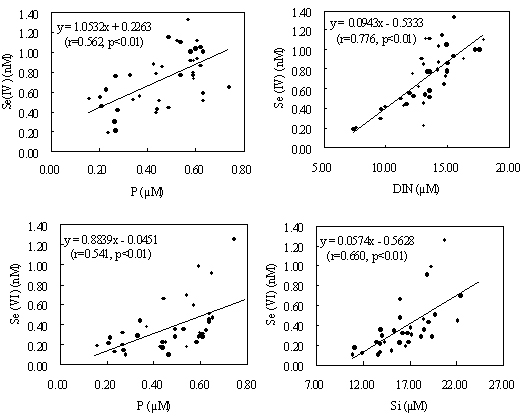
According to determining the biogeochemical behavior of selenium in Bohai Bay seawaters, Song Jinming and Duan Liqin et al. in Institute of Oceanology, Chinese Academy of Sciences found that selenium had the strong nutrient-type behavior.
Selenium concentration in Bohai Bay seawaters was required for the normal growth and development of phytoplankton. Selenium showed significant positive correlations with nutrients, chlorophyll a concentration and phytoplankton biomass, implying that selenium played a key role in regulating the phytoplankton productivity. The selenium in Bohai Bay seawaters mainly existed as selenite (Se(IV)) and selenate (Se(VI)) and the predominant speciation was selenate (Se(VI)), accounting for 66.7% of total selenium. The selenium concentrations in the surface and bottom waters decreased from the coastal waters to the central bay, with the highest value near the Haihe Estuary. This distribution pattern was related to the riverine inputs, environmental conditions and biological activities. In addition, in the region with the high phytoplankton biomass, the selenate concentrations were higher in the surface waters than in the bottom waters due to the biotic oxidation of selenite to selenate in the surface waters, suggesting that biological activities were a key factor controlling the selenium concentration in this region. Moreover, the riverine input was an important contribution to selenium of Bohai Bay and about 5670 t/yr of selenium reaches the Bohai Bay via rivers.
This study has been published in volume121 page 87-99 (2010) of Marine Chemistry, which is one of the Top 5 international journals of oceanography.
Selenium concentration in Bohai Bay seawaters was required for the normal growth and development of phytoplankton. Selenium showed significant positive correlations with nutrients, chlorophyll a concentration and phytoplankton biomass, implying that selenium played a key role in regulating the phytoplankton productivity. The selenium in Bohai Bay seawaters mainly existed as selenite (Se(IV)) and selenate (Se(VI)) and the predominant speciation was selenate (Se(VI)), accounting for 66.7% of total selenium. The selenium concentrations in the surface and bottom waters decreased from the coastal waters to the central bay, with the highest value near the Haihe Estuary. This distribution pattern was related to the riverine inputs, environmental conditions and biological activities. In addition, in the region with the high phytoplankton biomass, the selenate concentrations were higher in the surface waters than in the bottom waters due to the biotic oxidation of selenite to selenate in the surface waters, suggesting that biological activities were a key factor controlling the selenium concentration in this region. Moreover, the riverine input was an important contribution to selenium of Bohai Bay and about 5670 t/yr of selenium reaches the Bohai Bay via rivers.
This study has been published in volume121 page 87-99 (2010) of Marine Chemistry, which is one of the Top 5 international journals of oceanography.

